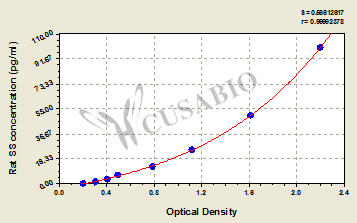Somatostatin (SST) is a cyclic peptide hormone that functions as a potent inhibitor of growth hormone release from the anterior pituitary gland. This neuropeptide also regulates the secretion of various hormones including insulin, glucagon, and thyroid-stimulating hormone, playing an essential role in metabolic homeostasis. Somatostatin is widely distributed throughout the central nervous system and peripheral tissues, where it acts through specific G-protein coupled receptors to modulate cellular signaling pathways. Its regulatory functions make it an important target for research in endocrinology, neuroscience, and metabolic disorders.
The Rat Somatostatin,SS ELISA Kit (CSB-E08204r) is designed for quantitative measurement of somatostatin in Rattus norvegicus samples. This sandwich ELISA works with serum, plasma, and tissue homogenates with a detection range of 1.56 pg/mL to 100 pg/mL and sensitivity of 0.39 pg/mL. The assay requires 50-100 μL sample volume and can be completed within 1-5 hours. Detection occurs at 450 nm wavelength, providing researchers with a reliable tool for somatostatin quantification in rat specimens.
Application Examples
Note: The following application examples are drawn from a selection of publications citing this product. For additional applications, please refer to the full list of references in the "Citations" section.
This ELISA kit has been used in gastrointestinal research to quantify somatostatin levels in tissue samples. The applications focus on measuring gastrointestinal hormone concentrations as part of broader endocrine profiling studies in rat models.
• Gastrointestinal hormone research: Quantification of somatostatin in transverse colon tissue homogenates alongside other gastrointestinal hormones including gastrin and cholecystokinin
• Endocrine profiling: Multi-hormone analysis examining somatostatin levels in conjunction with other regulatory peptides in gastrointestinal tissue samples
• Tissue-based biomarker studies: Measurement of somatostatin concentrations in homogenized colon tissue preparations using standardized extraction and measurement protocols




